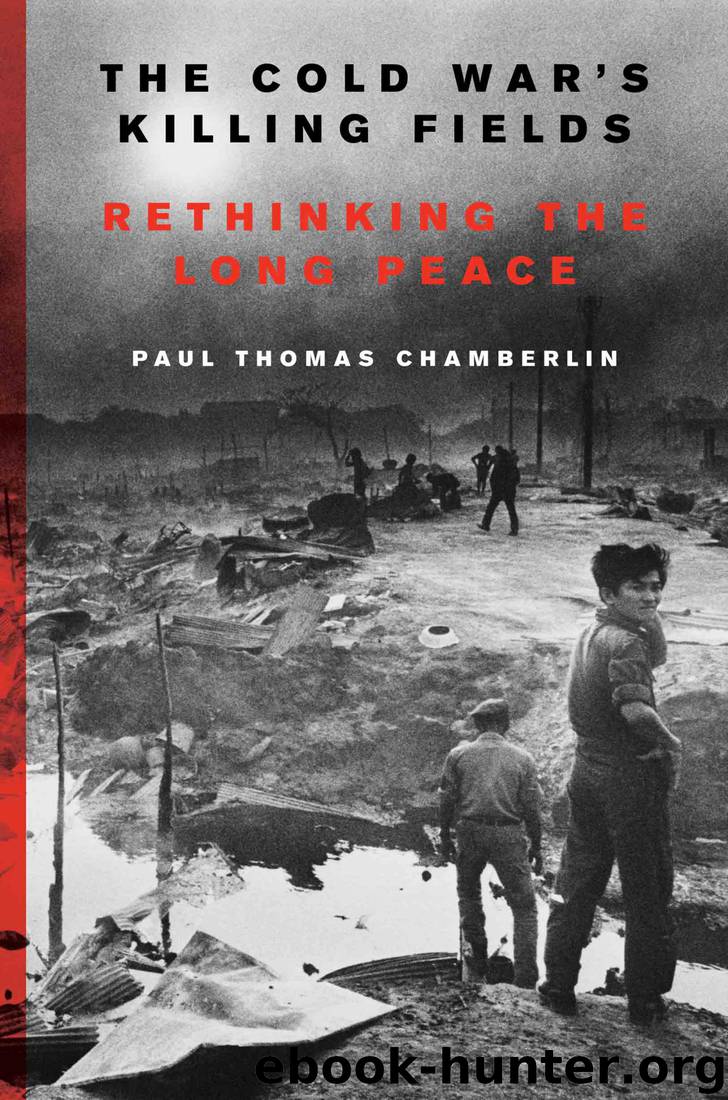The Cold War's Killing Fields: Rethinking the Long Peace by Paul Thomas Chamberlin

Author:Paul Thomas Chamberlin
Language: eng
Format: epub
Tags: 20th Century, Cold War, History, International Relations, Military, Political Science
Publisher: HarperCollins
Published: 2018-07-03T03:00:00+00:00
13
The Cambodian Nightmare
1975–1979
As dawn came to Phnom Penh on April 17, 1975, white sheets fluttered from windows throughout the city. Government leaders had ordered their forces to stand down, and the capital was now open to the Communist Khmer Rouge. Clad in black and wearing checked scarves, victorious Communist troops marched into the city. To the capital’s residents, the soldiers seemed strange—most came from the countryside, and few had ever seen a city as large as Phnom Penh. To the victors, the city appeared as a den of corruption and vice, the ultimate symbol of the regime’s depravity and the ruinous effects of foreign influence. Few soldiers smiled as they took control of strategic locations throughout the capital. Groups of Khmer Rouge entered the city’s hospitals, which were overflowing with wounded from the months-long siege. With little hint of mercy, the soldiers ordered patients and attendants to leave; some insisted that the evacuation was necessary to avoid imminent B-52 strikes. Men, women, and children with horrific injuries formed a gruesome procession down the staircases and out into the streets. Throughout the city, Communist soldiers pounded on the doors of homes and ordered those inside to leave immediately. They were to abandon their possessions and take only the clothes on their backs and what food they could carry. The roads out of the city were soon choked with some two million people. What few provisions the Communists gave them along the way were insufficient; the water ran out first. Bodies of the fallen were left along the sides of the road as thousands of refugees marched past. Foreigners took refuge first in the Hotel Phnom and then in the French embassy. The party forced all nonnationals out of the country within two weeks. Year Zero had begun.1
It was here in Cambodia—or Democratic Kampuchea, as the Khmer Rouge would rename the country—that the Cold War era’s darkest chapter would play out. For most Americans, the fall of Saigon was a tragedy; the fall of Phnom Penh and the butchery that followed barely registered. The regime’s extreme isolation was partly responsible for this. Khmer Rouge leaders did everything in their power to close their state off from foreign influence and eradicate its vestiges. But by 1975, many Americans both inside and outside the halls of power were eager to forget their painful involvement in Southeast Asia. Moving on was not so easy for those living in the region. Democratic Kampuchea sat at the center of a perfect storm in geopolitics. Centuries of hostility between Vietnam and Cambodia, the experience of French colonialism, and Japanese occupation during World War II formed a troubled foundation for Cambodian independence. Though its leader, Prince Norodom Sihanouk, had sought neutrality, the nation could not escape the tides of war sweeping through neighboring Vietnam. Hanoi, Saigon, Beijing, and Washington all helped turn Cambodia into a secondary battlefield of the Vietnam Wars.
Yet it was the Cambodians themselves who would perform most of the killing. The vicious logic of revolutionary communism
Download
This site does not store any files on its server. We only index and link to content provided by other sites. Please contact the content providers to delete copyright contents if any and email us, we'll remove relevant links or contents immediately.
| Africa | Americas |
| Arctic & Antarctica | Asia |
| Australia & Oceania | Europe |
| Middle East | Russia |
| United States | World |
| Ancient Civilizations | Military |
| Historical Study & Educational Resources |
The Radium Girls by Kate Moore(11626)
100 Deadly Skills by Clint Emerson(4695)
The Templars by Dan Jones(4561)
Rise and Kill First by Ronen Bergman(4548)
The Doomsday Machine by Daniel Ellsberg(4250)
The Rape of Nanking by Iris Chang(4024)
Killing England by Bill O'Reilly(3899)
Hitler in Los Angeles by Steven J. Ross(3803)
Stalin by Stephen Kotkin(3728)
12 Strong by Doug Stanton(3420)
Hitler's Monsters by Eric Kurlander(3165)
Blood and Sand by Alex Von Tunzelmann(3060)
Darkest Hour by Anthony McCarten(3019)
The Code Book by Simon Singh(2864)
The Art of War Visualized by Jessica Hagy(2842)
Hitler's Flying Saucers: A Guide to German Flying Discs of the Second World War by Stevens Henry(2625)
Babylon's Ark by Lawrence Anthony(2433)
The Second World Wars by Victor Davis Hanson(2423)
Tobruk by Peter Fitzsimons(2376)
